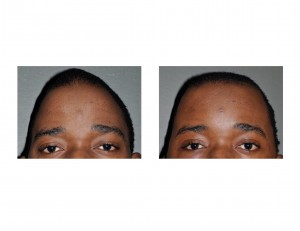
The following postoperative instructions for skull reshaping surgery are as follows:
1. Skull reshaping surgery has a surprisingly minimal amount of postoperative discomfort. Pain medications are prescribed should you need them and you should take them as directed on the label, usually 2 tablets every 3 to 4 hour as needed. Many patients only use Tylenol; or Alleve after the first few days of surgery.
2. There will be a circumferential head wrap applied at the end of the procedure. This is to be worn for the first night after surgery and can be removed the next day. Thereafter no dressings are needed. You may take it off the next day to shower.
3. In some cases of skull reshaping surgery, a drain will be used for the first day after surgery. This very small tube will be connected to a small bulb which collects any fluids. Empty the bulb as directed and there is NO need to measure the amount of fluid that comes out. In most cases of skull reshaping surgery, the bulb usually does not fill enough to be emptied more than once. The drain will be removed the day after surgery.
4. The scalp incision will be closed with either resorbable sutures, permanent sutures or small metal staples.There is no need to apply any antibiotic ointment to the incision, just leave them dry. Resorbable sutures do not need to be removed. Permanent sutures and staples will be removed 7 to 10 days after surgery. You may shower 48 hours after surgery and wash your hair.
5. You may wash your hair 48 hours after surgery. It is alright to get the sutures or staples wet. Dry and style your hair as desired. Be careful combing your hair so you do not catch the comb in the sutures or staples.
6. Strenuous physical activities and working out should wait for at least one week after surgery. While you can not harm the result by anything you do, wait until you feel better before exerting yourself.
7. You may eat and drink whatever you like right after surgery. Focus on liquids and soft foods for the first few days after surgery.
8. You may return to work and any non-strenuous physical activity as soon as you would like based on your comfort level.
9. You may drive when you feel comfortable and can react normally and are off pain medication.
10. If any scalp or incisional redness, tenderness, or drainage develops after the first week of surgery, call Dr. Eppley and have your pharmacy number ready.


